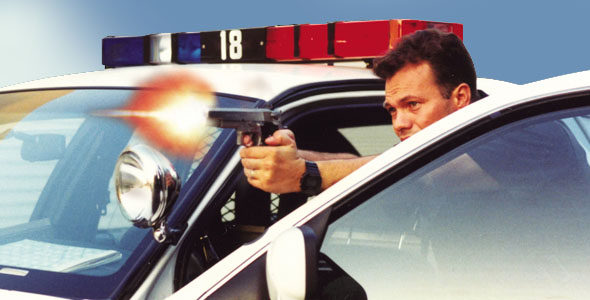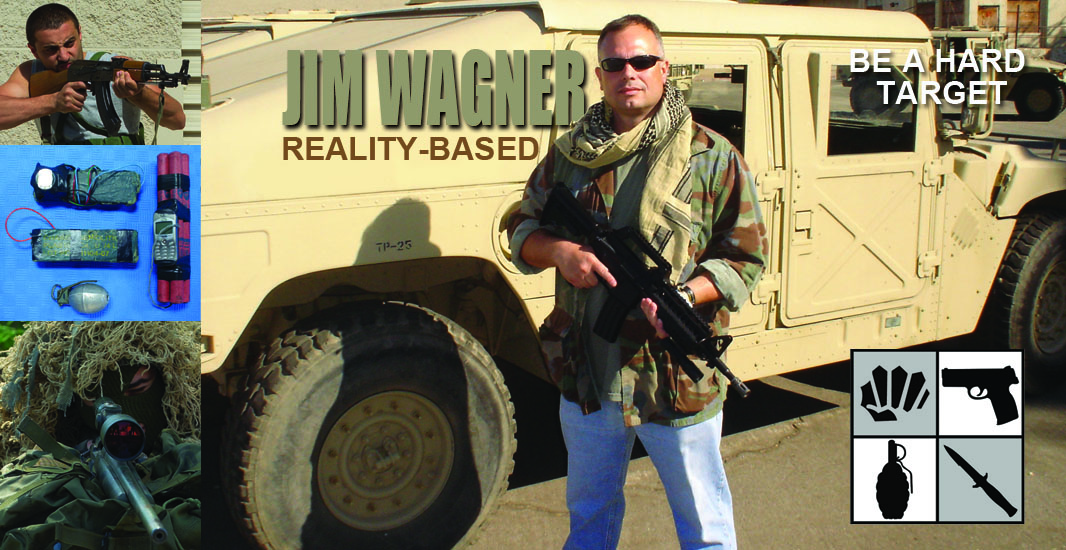Many martial artists tend to get involved in situations that most citizens would avoid; especially situations involving violence. The confidence building nature of self-defense courses creates more “good Samaritans” (individuals who are willing to come to the aid of someone in distress) than do most groups. It’s an admirable trait, but one that can get you hurt if you are not careful. For example, if you find yourself rendering aid to somebody who is being mugged or beaten, you not only run the risk of getting injured by the suspect yourself, but you could end up getting injured or killed by the police as well. That’s right, the police. But you can avoid being shot by police if you know how to act in certain situations involving the police.
Police mentality
When police officers arrive at a crime scene involving violence, they have no way of knowing who the “good guys” are and who the “bad guys” are. In some situations it may be obvious such as a gunman shooting at the police when they arrive, a person running from them, or a witness gave the dispatcher a very good description of the suspect. However, it’s not so obvious when the suspect ditches his weapon and blends in with the crowd or when a suspect lies to the police if confronted. Every situation is different, and there is no such thing as a “routine police call.”

Let’s say that you find yourself in the middle of a fight trying to subdue a criminal, and the police arrive while this is in progress. Your pure intentions may not be apparent to the police officers until they’ve had a chance to determine who all the “players” are. Don’t be surprised if at first you are treated like a suspect, because in the first few moments you will be.
Officer safety
Law enforcement officials rely on their training and experience to stay alive each day. The typical street cop responds to hundreds of violent calls per year. If they seem a little “paranoid,” they have reason to be. The most important rule that these professionals learn on the job is that EVERYONE IS CONSIDERED A THREAT until their identity can be determined. And, sometime this takes time to determine.
The same holds true for SWAT operations – everybody is considered hostile until proven otherwise. During the Columbine High School shooting on April 20, 1999, the beginning of the high school shooting phenomena, students were ordered to exit their classrooms with their hands on top of their heads as SWAT officers escorted them out with their MP5s (sub machine guns) at the ready. The SWAT officers, not knowing if the suspects, Eric Harris and Dylan Klebold, were hiding among the fleeing students or not, had to treat all the students as potential suspects. This tactic has its roots in the “Princess Gate” operation when on May 5, 1980 British SAS (Special Air Service commandos) conducted a hostage rescue operation on the Iranian embassy in London. Several terrorists were holding a large number of people hostages for political reasons. When room-clearing operations began, one of the terrorists mingled in with the women hostages, pretending to be a hostage so the assault force would not shoot him. The unusual dynamic that occurred in this particular situation was that several of the women were actually trying to protect the terrorist at the moment of rescue. This kind of behavior, known as the “Stockholm Syndrome” (sympathy, and even aid to captor) can sometimes develop between captive and captor. Thus, officers knowing this will treat all persons involved as suspects. This means pointing guns at everyone and even handcuffing everybody.
One day you may be just trying to help someone in need after an attack, or may even be protecting yourself if you’re the victim of a crime, and then you find yourself looking down the barrels of police guns as they point them right at you. Or worse yet, the police may even shoot you because you did not know how to react when contacted by them.
Needless to say, the public often misunderstands such treatment by the police, and it makes uninformed people very angry. The predictable feeling you will have if you are ever in this situation is, “How dare they treat me like a criminal!”
From the horse’s mouth
On several occasions, when I was a patrol officer with the Costa Mesa Police Department in California, I have pointed my Smith & Wesson 645 .45 caliber at innocent citizens, only later to have apologize to them and explain why I did it. The reasons varied: maybe they matched the description of a wanted suspect, or it was a case of mistaken identity, or perhaps they were directly involved in a situation and their involvement had not been determined at the moment of contact.
Once I came close to shooting a man, an innocent man, because he did not know how to act around the police. Here’s what happened.
It was about 11:30 in the morning. The manager of a local motel (a motel known for it’s high crime rate) phoned the police and said that four men where trying to steal an orange Camero car in the back parking lot of the motel. I was just down the street in my patrol car when I got the call, and I was the first officer to arrive on scene.
Sure enough, I saw the Camero and two men standing on each side of it. One man was shoving a slimjim (a tool used by tow truck drivers and car thieves to open a car door lock) between the slice of space of the driver’s door and window, as the other man appeared to be a “look out.” Two additional men where inside a second car that was directly behind the Camero with its engine was running. Based upon the report that came over my radio and Mobile Data Terminal, and what I was seeing with my own eyes, it appeared to be a crime in progress. I thought it strange that someone would be stealing a car in broad daylight, but I wasn’t going to take any chances. I was going to follow Standard Operating Procedures.
I drew my pistol and told everyone to get their hands up in the air. My goal was to contain everyone until my follow-up arrived. The two men next to the Camero raised their hands into the air and dropped their tools, as did the driver of the “getaway car.” Then, the passenger, refusing to put his hands up while inside the car, kicked open the car door with his boot, stepped out, and started to walk directly towards me with his right hand behind his back as if concealing something. I yelled, “STOP! STOP!” but he kept coming. I didn’t know if he was going to produce a gun from his back or what, but I took a couple steps backwards towards a parked van and gave him one more chance to stop before I took cover and started shooting. He kept aggressing me, and I started to pull the trigger back as I took aim at the center of his chest. There was no way I was going to let this man get any closer to me.
The man’s friends, pleading for him to stop, and they must have gotten through to him because suddenly he stopped and put both hands to his sides. His right hand was empty. I took my index finger off the trigger and placed it back along side the receiver in a ready position. By this time other police cars began pouring into the parking lot.
As it turned out, the man (who never realize how close he came to getting shot that day) was drunk and just being stupid. The Camero in question belonged to one of the men’s girlfriend, who had lost the keys the night before. They were just trying to her help out by breaking into the car and getting driving it back to her.
Of course, you don’t have to be drunk to make a mistake with the police. One of the duties of law enforcement officers is to pull over vehicles for traffic violations. Occasionally the police will get a driver who will shove the vehicle in park and immediately step out. The first thing that any police officer thinks when this happens is, “This person is going to attack me,” because many police officers are shot each year during traffic stops. Needless to say, somebody suddenly getting out of the vehicle forces the officer to take immediate action, and it’s not usually an action the citizen likes. If someone unexpectedly gets out of his or her vehicle when I’m making the stop, I will draw my pistol and prepare myself for the ambush. It may not be pointed at them, but it will definitely be in a low-ready position until I can determine their intentions. Then I will firmly tell them to get back into the car or go sit on the curb, depending upon the situation. The law abiding citizen gets a little bent out of shape over this authoritative behavior, but then again, the average person just waits in the vehicle until the officer makes contact with them. The people who jump out of their vehicles during a police car stop are either going to do one of three things: attack, run away, or act stupid.
Give the police a break. It’s very unnerving to be treated like a suspect by the police, but just remember that the police don’t know you. It’s nothing personal. When they first arrive to a crime scene they don’t know if they are being set up for an ambush, whether the information they received from the dispatcher is accurate or not, or whether you’re the suspect, the victim or the witness. You just need to accept the fact that the police may treat you cautiously at first. There are key things that you should do (and should not do) whenever the police make contact with you. They are:
Keep your hands in plain sight. When the police arrive make sure they can clearly see your hands. If you have them in your pockets or your body is angled in such a way that they cannot see a hand, then you will be considered armed until the police officers can see that you are not hiding a weapon.
Don’t make any sudden moves. If you were just involved in a fight you may be quite hyperactive from the excitement. Remain calm and don’t make sudden moves that may be interpreted as going for a weapon or taking an offensive posture. For example, if asked to show your identification, don’t suddenly reach for your wallet. Quick movement like that makes the police extremely nervous.
Don’t approach the police. When the police arrive, don’t run towards them. They do not know your intentions and it may appear to them as if you’re going to attack them. Let the police officers come to you. Just a reminder, if you are pulled over in your car by the police, remain inside the vehicle with both hands on the steering wheel or on your knees if you are a passenger. Don’t get out unless asked to do so. Getting out of the vehicle without permission will be considered aggressive until the police officer can determine your intentions.
Do as you’re told. Comply with all legal orders given by the police. Let them do their job of finding out what’s going on. Cooperate with them and don’t throw a fit if you think they are being rude to you. An officer may cut you off in conversation, or demand that certain answers be given first. By following orders you can get to the business at hand sooner and let the police know the extent of your involvement.
Don’t joke around. The police are not people you want to joke around with. For example, you might get shot if you suddenly point your finger at an officer approaching you. I’m reminded of a 16-year-old male in California who pointed a squirt gun at a police officer when positioned side by side at a traffic signal. The officer turned and fatally shot the kid. The shooting was justified.
In some situations the police must determine if a person is mentally disturbed or not. They may ask you, “Are you thinking of hurting yourself or others?” If you joke around and say, “Yea, I’m going to kill myself,” you may find yourself taking a trip to the local mental health facility. The police do not joke around about things like this.
Don’t set yourself up for disaster. If you think you hear a burglar on the exterior of your home trying to break in, and you have called the police, do not go outside looking for the burglar. Several people have been killed in the past when the police mistook the resident for the burglar. Such incidents usually occurred when the resident was armed for self-defense, and unexpectedly ran into the police. Most police dispatchers will tell the caller to stay indoors to avoid such mishaps. The same common sense applies to store owners, jewelry dealers transporting their goods, a student going to the dojo transporting training weapons, or anyone else who may be armed. When the police arrive, do not be found with a weapon in your hand.
Most people have never had any direct contact with the police. Statically those who have had contact with the police it’s usually because of a traffic stop for a minor traffic violation. Thus, it’s not unusual that many people are not sure how to act in certain situations involving the police. The pointers I have given you may help keep you safe should you ever find yourself being contacted by the police.
Be A Hard Target






